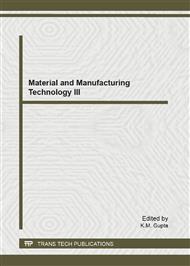p.839
p.843
p.848
p.853
p.860
p.865
p.870
p.875
p.880
TG/DSC Comparison of Sulfur Microcapsule Prepared in Scale-Up Vs in Lab Level
Abstract:
Sulfur is an important raw chemical industry material which is widely used in a variety of industries. In recent years, several new natural gas purifying plants was built in Sichuan province, the availability of sulfur has considerably grown. New sulfur applications should be innovated to meet the sulfur consumption. The main use of sulfur is vulcanizing the rubber as an agent. With the increase of the vulcanizing temperature, however, the solubility of sulfur in the rubber will become bigger, the more amount of sulfur additive should be needed which results in the isolation of sulfur appearing on the rubber surface. The isolation will not only damage the appearance but also lower the surface adhesion of the rubber which can make the bondage process more difficult. For the purpose of decreasing the isolation, it is necessary to select vulcanizing agent with bigger relative molecular mass, the appropriate amount and control the positive vulcanizing strictly. The two main solutions for avoiding isolation are: (1) choosing the vulcanizing agent with bigger relative molecular mass, i.e. IS (insolvable sulfur) [1]; and (2) using the encapsulated sulfur [2]. For the reason of huge energy cost and toxicity in the IS production, the encapsulated sulfur preparation method is introduced. In this paper, a scale-up sulfur encapsulating process was planned and carried out after the lab trial was successfully finished. The TG/DSC analysis was made to investigate the thermal characteristics of the sulfur microcapsule.
Info:
Periodical:
Pages:
860-864
Citation:
Online since:
July 2012
Authors:
Price:
Сopyright:
© 2012 Trans Tech Publications Ltd. All Rights Reserved
Share:
Citation:


